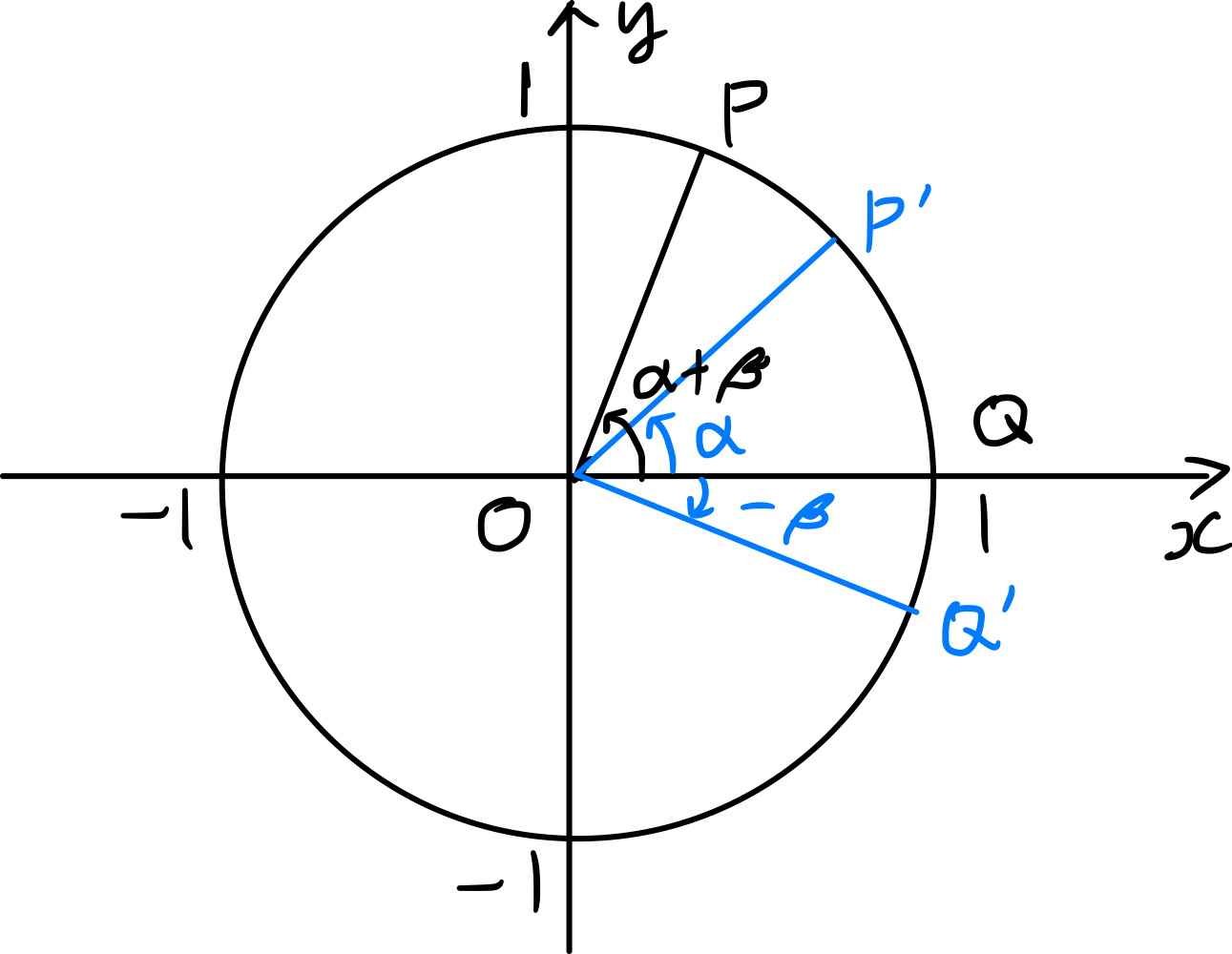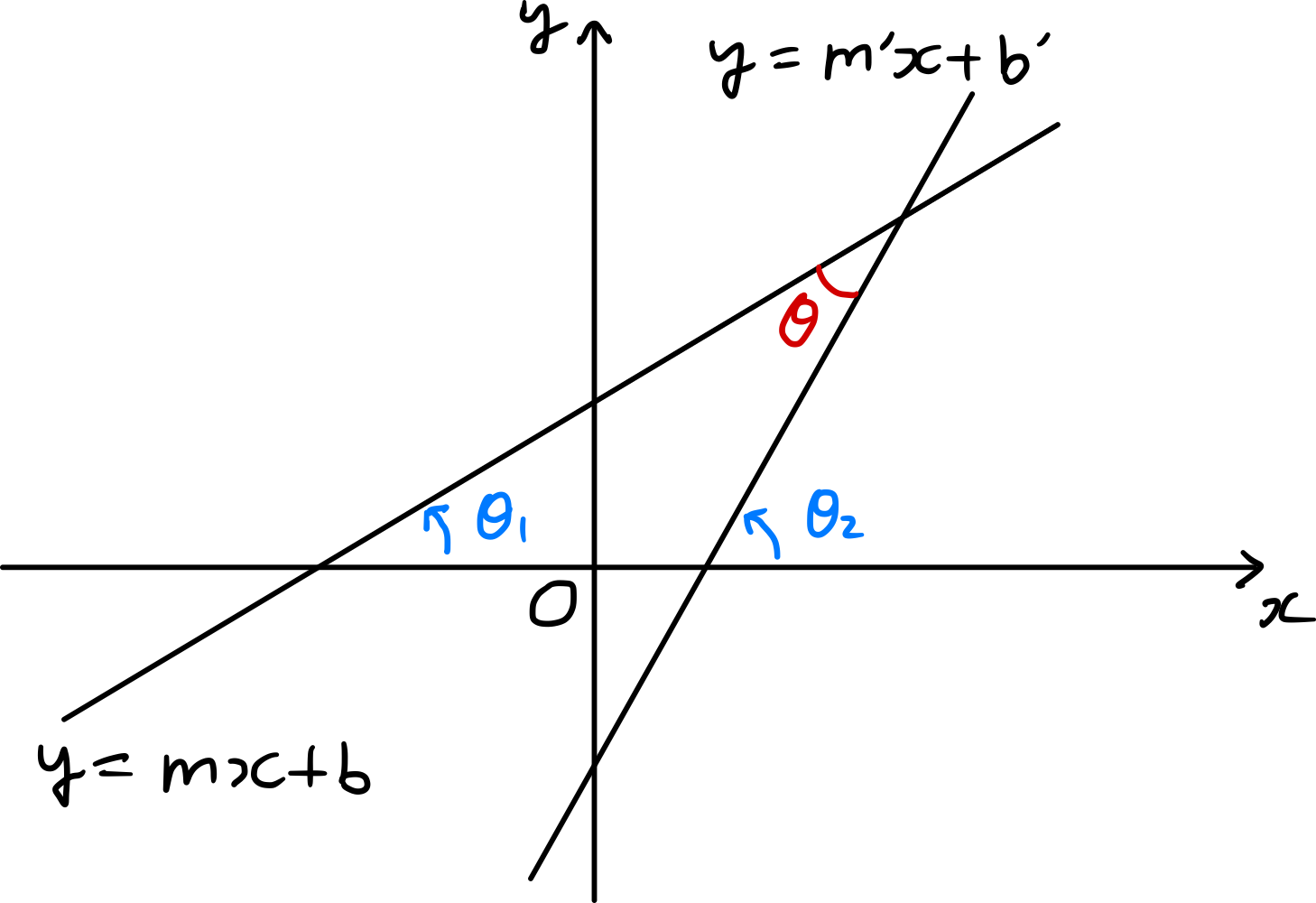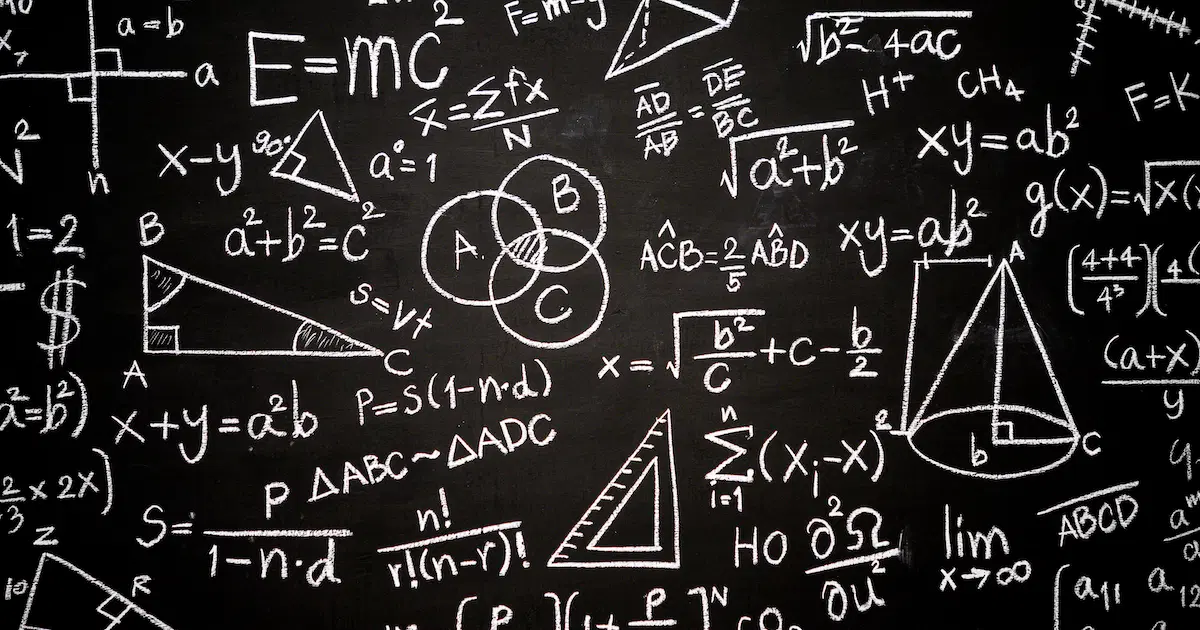Addition Formulas for Trigonometric Functions
Examine the definitions of trigonometric functions and the relationships between them, and derive the addition formulas for trigonometric functions and their derivative formulas.
Definition of Trigonometric Functions
 As shown in the figure, when the angle between the radius vector $\overline{OP}$ and the positive direction of the $x$-axis is $\theta$, \(\begin{gather}\begin{split} \sin \theta = \frac { y } { r } ,\; \cos \theta = \frac { x } { r } ,\; \tan \theta = \frac { y } { x } \\ \csc \theta = \frac { r } { y } ,\; \sec \theta = \frac { r } { x } ,\; \cot \theta = \frac { x } { y } \end{split}\end{gather}\) are defined as such, and collectively called trigonometric functions.
As shown in the figure, when the angle between the radius vector $\overline{OP}$ and the positive direction of the $x$-axis is $\theta$, \(\begin{gather}\begin{split} \sin \theta = \frac { y } { r } ,\; \cos \theta = \frac { x } { r } ,\; \tan \theta = \frac { y } { x } \\ \csc \theta = \frac { r } { y } ,\; \sec \theta = \frac { r } { x } ,\; \cot \theta = \frac { x } { y } \end{split}\end{gather}\) are defined as such, and collectively called trigonometric functions.
Relationships Between Trigonometric Functions
- \[\csc \theta = \frac { 1 } { \sin \theta } ,\; \sec \theta = \frac { 1 } { \cos \theta } ,\; \cot \theta = \frac { 1 } { \tan \theta } \tag{2}\]
- \[\tan \theta = \frac { \sin \theta } { \cos \theta } ,\; \cot \theta = \frac { \cos \theta } { \sin \theta } \tag{3}\]
- \[\tag{4} \begin{gather*} \sin ^ { 2 } \theta + \cos ^ { 2 } \theta = 1 \\ \tan ^ { 2 } \theta + 1 = \sec ^ { 2 } \theta \\ 1 + \cot ^ { 2 } \theta = \csc ^ { 2 } \theta \end{gather*}\]
Addition Formulas for Trigonometric Functions
 As shown in the figure, let $P, Q, P^{\prime}, Q^{\prime}$ be the points where four radius vectors forming angles of $\alpha+\beta,\, 0,\, \alpha,\, -\beta$ with the positive direction of the $x$-axis intersect the unit circle.
As shown in the figure, let $P, Q, P^{\prime}, Q^{\prime}$ be the points where four radius vectors forming angles of $\alpha+\beta,\, 0,\, \alpha,\, -\beta$ with the positive direction of the $x$-axis intersect the unit circle.
The coordinates of the two points $P, Q$ are
\[P(\cos(\alpha+\beta), \sin(\alpha+\beta)),\; Q(1,0)\]therefore
\[\begin{align*} \overline { P^ { \prime } Q^ { \prime } } ^2&= \{ \cos \alpha - \cos ( - \beta ) \} ^ { 2 } + \{ \sin \alpha - \sin ( - \beta ) \} ^ { 2 } \\ &= 2 - 2 \cos \alpha \cos ( - \beta ) - 2 \sin \alpha \sin ( - \beta ) \\ &= 2 - 2 \cos \alpha \cos \beta + 2 \sin \alpha \sin \beta. \end{align*}\]Since $\overline{PQ}=\overline{P^{\prime} Q^{\prime}}$, $2 - 2 \cos ( \alpha + \beta ) = 2 - 2 \cos \alpha \cos \beta + 2 \sin \alpha \sin \beta.$
\[\therefore \cos ( \alpha + \beta ) = \cos \alpha \cos \beta - \sin \alpha \sin \beta. \label{eqn:cos_1} \tag{5}\]Substituting $-\beta$ for $\beta$ in the above equation and simplifying:
\[\cos ( \alpha - \beta ) = \cos \alpha \cos \beta + \sin \alpha \sin \beta \label{eqn:cos_2} \tag{6}\]Since $\cos ( \frac { \pi } { 2 } - \theta ) = \sin \theta ,\, \sin ( \frac { \pi } { 2 } - \theta ) = \cos \theta$,
\[\begin{align*} \sin ( \alpha + \beta ) &= \cos ( \frac { \pi } { 2 } - ( \alpha + \beta ) ) = \cos ( ( \frac { \pi } { 2 } - \alpha ) - \beta) \\ &= \cos ( \frac { \pi } { 2 } - x ) \cos \beta + \sin ( \frac { \pi } { 2 } - \alpha ) \sin \beta \\ &= \sin \alpha \cos \beta + \cos \alpha \sin \beta. \end{align*}\] \[\therefore \sin ( \alpha + \beta ) = \sin \alpha \cos \beta + \cos \alpha \sin \beta. \label{eqn:sin_1} \tag{7}\]Substituting $-\beta$ for $\beta$ in this equation and simplifying:
\[\sin ( \alpha - \beta ) = \sin \alpha \cos \beta - \cos \alpha \sin \beta. \label{eqn:sin_2} \tag{8}\]Finally,
\[\tan ( \alpha + \beta ) = \frac { \sin ( \alpha + \beta ) } { \cos ( \alpha + \beta ) } = \frac { \sin \alpha \cos \beta + \cos \alpha \sin \beta } { \cos \alpha \cos \beta - \sin \alpha \sin \beta }\]Dividing both numerator and denominator by $\cos{\alpha} \cos{\beta}$ and simplifying:
\[\tan ( \alpha + \beta ) = \frac { \tan \alpha + \tan \beta } { 1 - \tan \alpha \tan \beta } \label{eqn:tan_1} \tag{9}\]Substituting $-\beta$ for $\beta$ in this equation and simplifying:
\[\tan ( \alpha - \beta ) = \frac { \tan \alpha - \tan \beta } { 1 + \tan \alpha \tan \beta } \label{eqn:tan_2} \tag{10}\]Acute Angle Formed by Two Lines with Given Slopes
 Using equation ($\ref{eqn:tan_2}$), we can find the size of the acute angle formed by two lines with given slopes. If $\theta_{1}$ and $\theta_{2}$ are the angles that two lines $y=mx+b$ and $y=m^{\prime} x+b^{\prime}$ make with the positive direction of the $x$-axis, respectively, then
Using equation ($\ref{eqn:tan_2}$), we can find the size of the acute angle formed by two lines with given slopes. If $\theta_{1}$ and $\theta_{2}$ are the angles that two lines $y=mx+b$ and $y=m^{\prime} x+b^{\prime}$ make with the positive direction of the $x$-axis, respectively, then
Therefore, if $\theta$ is the size of the acute angle formed by the two lines,
\[\tag{11} \begin{align*} \tan{\theta}&=\left\vert \tan{\theta_{2}-\theta_{1}} \right\vert=\left\vert \frac{\tan{\theta_2}-\tan{\theta_1}}{1+\tan{\theta_1}\tan{\theta_2}}\right\vert \\ &=\left\vert \frac{m-m^{\prime}}{1+mm^{\prime}} \right\vert. \end{align*}\]